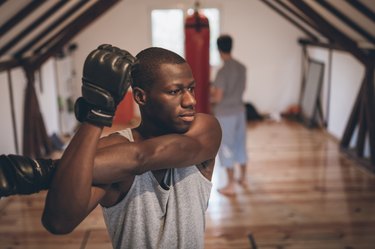
Whether you're looking for a challenging cardio workout to mix things up or just want to feel badass on your weight-loss journey, kickboxing won't let you down. It's a full-body workout that helps to build strength and cardiovascular fitness.
But as fun as it is to hit the gym, it isn't always feasible. Sometimes you just want to stay home and have a great kickboxing workout that aligns with your schedule. And you know what? It's totally doable!
Video of the Day
Video of the Day
Read more: Benefits of Cardio Kickboxing
Expert Tips for At-Home Kickboxing Workouts
Doing kickboxing workouts at home can be great, especially if you prefer exercising solo. But there are a few things you'll want to keep in mind before converting your living room into an at-home kickboxing studio.
1. Go Easy at the Start
Cardio kickboxing is known for leaving its participants almost breathless. "The general rule is that if you can talk, you didn't go hard enough!" says Zachary Phillips, martial artist and kickboxing coach.
That said, if you're an absolute beginner, you need to go easy on yourself to avoid getting injured or burning out. "Rome wasn't built in a day. You can't come in thinking you're Bruce Lee or Mike Tyson after five workouts; it's not going to happen," says Le Jon Guillory, kickboxing instructor at Body by Le Jon.
So start off with shorter sessions, master the techniques and monitor how your body responds. According to former professional kickboxer and gym owner, Jimmy Fusaro, no more than eight rounds of three minutes each is a good starting point.

2. Set Aside Some Space
The amount of space you have impacts the effectiveness of your training. After all, you don't want to be kicking your sofa. So if you're working out without a bag, you should have at least your height in space behind you (so if you're six feet tall, you'll need six feet of space) and half your height on each side, says Joseph Andreula, CEO of CKO Kickboxing.
On the other hand, if you'll be working with a standing bag, you'll typically need about 100 square feet of space, says Guillory. If you can afford to dedicate an entire room (or at least a good percentage of a large room), that would probably be best.
3. Learn to Breathe Correctly
If there's one thing that can make or break your kickboxing workout (or any workout, really) — it's breathing. "I don't care how big or how strong you are, if you don't know how to breathe, you won't be able to produce the amount of power you're trying to create with your punch or kick," says Guillory.
Kickboxing is mostly a cardiovascular exercise, so if you want to last long in the ring (or on the mat), you need to optimize your breathing. "Inhale through the nose and exhale through the mouth when you strike," Andreula says. "Focus on your breathing as you strike."
4. Get Geared Up
While shadow kickboxing (kickboxing without a bag) requires nothing but the motivation to keep punching, it's not quite the same when working with a bag. So if you need to let out frustrations on a bag, Andruela recommends a free-standing Muay Thai bag, resting on the ground, for at-home kickboxing. That's because it allows you to incorporate low kicks.
That said, the Muay Thai bag offers a formidable resistance when hit, so make sure to protect your limbs with hand wraps, boxing gloves and shin guards. "If you're punching the bag and your hands aren't properly wrapped, you create this soreness around your wrist, and I don't wish that upon anyone," Guillory says. Wrapping your hands can also help prevent you from breaking or fracturing your fingers and hands as well as spraining your wrists.
Read more: At-Home Gym Ideas for Every Budget
5. Put Safety First
Safety precautions are very important with at-home kickboxing workouts because you won't have a coach or trainer on-site to guide you. Phillips recommends having a couple of sessions with a kickboxing instructor to learn proper form before striking out on your own (pun definitely intended). And here are a few other safety tips to keep in mind:
- Always warm up for at least three to five minutes before your workout. Jumping rope and dynamic stretches are both great options.
- Don't lock out your elbow during shadow kickboxing. "Extend your arm or leg to around 90 percent and pull it back in," Andreula says.
- Keep a straight, strong wrist when throwing a punch.
- When throwing a kick, strike with the shin or instep — never with the toes.
- "Don't punch walls... the wall always wins," Fusaro says.
Read more: Why Is Kickboxing a Good Workout?

Beginner Kickboxing Moves to Master
Essentially, kickboxing boils down to two basic moves — punching and kicking. But before you do either, you need to establish a proper fighting stance.
Stand with feet shoulder-width apart and bring your dominant leg back, slightly bending your knees. Bring your fists to your face, keeping them loose. They should only clench when you're making contact.
Basic Punches
1. Jab: With the lead hand (the one in front), punch straight out, keeping the wrist straight and turning the fist palm down as you make contact. Rotate your lead shoulder forward and transfer your weight to your lead foot as your arm extends. At the same time, keep your rear hand high by your cheek to protect your face.
2. Cross: Just like the jab, the cross is a straight punch. With the rear hand, begin by turning from your rear hip and onto the ball of your rear foot, and then extend your rear arm straight out, turning the palm down and keeping the wrist straight. Keep your lead hand high by your cheek to protect your face.
3. Hook: Hooks are a rotational strike and one of the most advanced punches. They are thrown with your arms at a 90-degree angle (like you're holding a coffee mug). Pivot onto the ball of your foot while your hips and shoulders turn, generating power through your fist. Keep the thumb wrapped and the wrist straight. Your fist, elbow and shoulder should be parallel to the floor at the point of contact. Your opposite hand should be high up to protect your face.
4. Uppercut: As a beginner, throw the uppercuts palms up at bellybutton level, turning the hips with each punch. Keep your opposite hand high up to protect your face.
Basic Kicks
1. Front Kick: Raise the knee to the chest and kick the bag with the bottom of the foot. Extend your hips forward as your foot shoots out, connecting with the ball of your foot. This type of kick should be like a stab or poke. Afterward, bring the leg back to its original position.
2. Roundhouse Kick: Step out with the lead leg, opening up the hips. Rotate on your foot, turning the toes of your planted foot outward as your hips turn past the point of impact. Strike the bag with the rear leg shin or instep, and then bring the leg back to its original position. Imagine kicking through the target to help you develop the proper technique.
Put It All Together
Now that you've learned the basics, you need to put it to practice. So get off your chair and get ready to torch those calories. Try this cardio kickboxing circuit, or check out Daily Burn and Title Boxing On Demand for streaming workouts to do at home.
Read more: 10 Reasons to Ditch the Gym for At-Home Workouts